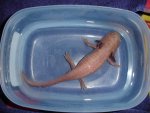Elspeth
New member
- Joined
- Feb 15, 2009
- Messages
- 47
- Reaction score
- 3
- Points
- 0
- Age
- 39
- Location
- Australia
- Country
- Australia
- Display Name
- Elspeth
Hi,
I've looked through alot of the forums to try and find the answer to get my axolotl better, and even asked in the chat room. But now im not sure sure.
I think it was a compaction illness, so i put her in the fridge an she passed some stones in a matter of hours. I left her in the fridge over night and she looked not so red the next day, so i toke her out of the fridge and put her back into the tank early in the morning.I checked on her at lunch time but her behaivour was still a bit sad, so i put her back in the fridge.
its been 2 days so far and she still hasent returned to her normal colour and viens are still promenent.
Should i just keep her in the fridge untill she does return to normal colour?
Thanks, i will be eternaly gratefull for any help.
Elspeth.
P.S i have since changed the substrate to larger gravel.
I've looked through alot of the forums to try and find the answer to get my axolotl better, and even asked in the chat room. But now im not sure sure.
I think it was a compaction illness, so i put her in the fridge an she passed some stones in a matter of hours. I left her in the fridge over night and she looked not so red the next day, so i toke her out of the fridge and put her back into the tank early in the morning.I checked on her at lunch time but her behaivour was still a bit sad, so i put her back in the fridge.
its been 2 days so far and she still hasent returned to her normal colour and viens are still promenent.
Should i just keep her in the fridge untill she does return to normal colour?
Thanks, i will be eternaly gratefull for any help.
Elspeth.
P.S i have since changed the substrate to larger gravel.


